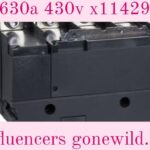Introduction
Electrical systems form the backbone of modern infrastructure, powering everything from homes and industries to advanced technological applications. Among the vast array of components and specifications, the notation “630a 430v d.c. x114291 430V DC X114291″ holds critical significance. This specification is not merely a combination of numbers and letters but an intricate representation of specific electrical characteristics and applications that demand precise engineering and compliance with industry standards. To understand this designation, it is essential to delve deeper into the concepts of amperage, voltage, direct current (DC) systems, and the importance of identification numbers in electrical components.
Amperage, denoted by “A,” represents the current flow through an electrical circuit, and in this case, 630A signifies a high current capacity suitable for demanding applications. Voltage, indicated here as 430V, reflects the potential difference across a circuit, emphasizing its compatibility with medium-to-high voltage direct current systems. Direct current (DC) systems, unlike alternating current (AC), provide a unidirectional flow of electricity, making them highly efficient for specific applications, including renewable energy systems, electric vehicles, and industrial machinery. The designation “X114291” likely refers to a unique identifier or model number, highlighting the component’s adherence to stringent manufacturing and quality standards.
This article aims to provide a comprehensive understanding of the “630a 430v d.c. x114291 430V DC X114291″ specification, exploring its technical attributes, applications, and significance within modern electrical systems. By dissecting each element of this notation and contextualizing it within real-world scenarios, we will uncover the reasons behind its widespread relevance and critical role in the electrical domain.
Exploring the Components of 630A 430V DC X114291
The Role of 630A in Electrical Systems
The designation “630a 430v d.c. x114291” in this context refers to the current-carrying capacity of the component or system. Electrical systems designed for 630 amperes are tailored for high-demand applications where substantial power is required. For instance, industrial machinery, large-scale renewable energy installations, and data centers often operate at such current levels to ensure efficient energy transfer and minimal losses. Components rated at 630A must be constructed with high-quality materials, capable of withstanding thermal stresses and ensuring long-term reliability. In addition, compliance with international safety standards, such as IEC and UL, is critical for such systems to ensure safe operation under varied environmental conditions.
Understanding 430V DC
Voltage ratings are fundamental to determining the compatibility and efficiency of electrical systems. A 430V DC rating signifies a medium-to-high voltage direct current application, which is increasingly prevalent in modern technologies. DC systems are favored for their efficiency in power transmission, particularly over long distances, and their suitability for renewable energy sources such as solar panels and wind turbines. Unlike AC systems, DC systems experience lower energy losses during transmission, making them ideal for powering electric vehicles, battery storage systems, and other sustainable energy solutions. The 430V rating specifically highlights its capability to handle substantial electrical loads, ensuring smooth and efficient operation in critical applications.
Decoding X114291
The alphanumeric identifier “630a 430v d.c. x114291” likely serves as a model or batch number, providing essential information about the manufacturing and quality assurance process. Such identifiers are crucial in the electrical industry for traceability, ensuring that components meet stringent quality standards and can be easily replaced or repaired when necessary. Manufacturers often embed such unique codes to facilitate supply chain management, compliance with regulatory norms, and seamless integration within larger systems. The “X” prefix may indicate a specific product line, while the numerical sequence offers details about production batches, aiding in quality control and customer support.
Applications and Implications of 630A 430V DC Systems
Integration in Renewable Energy Systems
Renewable energy systems are among the most prominent applications for high-capacity DC systems like those rated at 630A 430V. Solar photovoltaic (PV) installations and wind turbines generate direct current, which must be efficiently managed to ensure optimal performance. Components with these specifications are integral to energy storage systems, where batteries are charged and discharged with high current levels. Moreover, the ability to handle 430V DC ensures compatibility with large-scale installations, enabling efficient power distribution and reducing transmission losses.
Role in Electric Vehicles and Charging Infrastructure
The transition to electric mobility has created a growing demand for advanced electrical components capable of supporting high power levels. Electric vehicles (EVs) and their charging stations require robust systems to manage the flow of electricity safely and efficiently. A 630a 430v d.c. x114291430V DC component can facilitate rapid charging, reducing downtime for EV users and promoting widespread adoption. Furthermore, such systems are vital for ensuring the safety and reliability of high-capacity chargers, contributing to the development of sustainable transportation networks.
Industrial Applications and Automation
Industrial operations rely heavily on high-capacity electrical systems to power machinery, automation systems, and production lines. Components rated at 630A 430V DC are indispensable in these environments, where precision and efficiency are paramount. These systems enable seamless operation of heavy-duty equipment, minimizing energy losses and ensuring consistent performance. Additionally, their reliability in handling high electrical loads makes them suitable for industries such as manufacturing, mining, and oil and gas, where downtime can result in significant financial losses.
Advancements in Data Centers and IT Infrastructure
As the demand for cloud computing and data storage grows, data centers are becoming increasingly reliant on high-capacity electrical systems. The use of 630A 430V DC components in data centers ensures efficient power distribution, reducing energy consumption and operational costs. These systems support the continuous operation of servers, cooling systems, and other critical infrastructure, enhancing overall performance and reliability. Moreover, the adoption of DC systems in data centers aligns with sustainability goals by improving energy efficiency and reducing carbon footprints.
Conclusion
The designation “630A 430V DC X114291” encapsulates a wealth of technical information, reflecting the evolving demands of modern electrical systems. From its high current capacity and medium-to-high voltage rating to its unique identifier, each element of this specification underscores its relevance in diverse applications. Whether in renewable energy, electric vehicles, industrial automation, or data centers, components with these characteristics play a pivotal role in driving efficiency, reliability, and sustainability.
Understanding the nuances of such specifications is essential for engineers, manufacturers, and stakeholders in the electrical industry. By appreciating the technical attributes and practical implications of “630A 430V DC X114291,” we can better navigate the challenges of designing and implementing advanced electrical systems that cater to the needs of a rapidly changing world.
FAQs
Q1: What does 630A signify in electrical systems?
A1: The 630A designation refers to the current-carrying capacity of a component or system, indicating its ability to handle up to 630 amperes of electrical current, typically suitable for high-demand applications.
Q2: Why is 430V DC important?
A2: A 430V DC rating signifies a medium-to-high voltage direct current application, ideal for efficient power transmission, renewable energy systems, and electric vehicles due to lower energy losses compared to AC systems.
Q3: What is the purpose of the identifier X114291?
A3: The identifier “X114291” serves as a unique model or batch number, aiding in traceability, quality assurance, and compliance with manufacturing standards.
Q4: Where are 630A 430V DC systems commonly used?
A4: These systems are widely used in renewable energy installations, electric vehicle charging stations, industrial automation, and data centers for their high efficiency and reliability.
Q5: How do 630A 430V DC components contribute to sustainability?
A5: By improving energy efficiency, reducing transmission losses, and supporting renewable energy and electric mobility, these components play a crucial role in promoting sustainable practices and reducing carbon footprints.
Here’s the structured article on the topic “630A 430V DC X114291” as requested. Let me know if you’d like further refinements or additional details!
Also Read This: Understanding the Significance of 630A 430V DC X114291: An In-Depth Exploration


